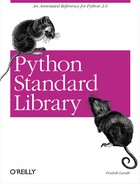(Optional) The crypt module implements one-way DES encryption. Unix
systems use this encryption algorithm to store passwords, and this
module is really only useful to generate or check such passwords.
Example 2-40 shows how to encrypt a password by calling crypt.crypt with the
password string, plus a salt, which should consist of
two random characters. You can now throw away the actual password,
and just store the encrypted string.
To verify a given password, encrypt the new password using the two
first characters from the encrypted string as the salt. If the result
matches the encrypted string, the password is valid. Example 2-41 uses the pwd module to fetch the
encrypted password for a given user.
Example 2-41. Using the crypt Module for Authentication
File: crypt-example-2.py
import pwd, crypt
def login(user, password):
"Check if user would be able to log in using password"
try:
pw1 = pwd.getpwnam(user)[1]
pw2 = crypt.crypt(password, pw1[:2])
return pw1 == pw2
except KeyError:
return 0 # no such user
user = raw_input("username:")
password = raw_input("password:")
if login(user, password):
print "welcome", user
else:
print "login failed"For other ways to implement authentication, see the description of the
md5 module.
